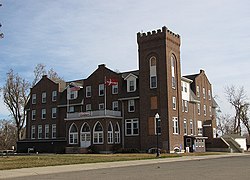Danebod
|
Danebod
|
|

Danebod Folk School, 2007
|
|
| Location | Danebod Ct., Tyler, Minnesota |
|---|---|
| Coordinates | 44°16′05″N 96°08′01″W / 44.26806°N 96.13361°WCoordinates: 44°16′05″N 96°08′01″W / 44.26806°N 96.13361°W |
| Area | 79 acres (0.32 km2) |
| Built | 1888 |
| Architectural style | b |
| NRHP Reference # | 75000993 |
| Added to NRHP | June 30, 1975 |
Danebod (pronounced "DAHN-a-bo", or "DAN-a-bo") is a historic district at the south edge of the railway town of Tyler in southwestern Minnesota. Founded in 1885 by Danish Evangelical Lutherans led by Rev. Hans Jørgen Pedersen (1851–1905), the district comprises a group of buildings dating back to 1888 from Minnesota's oldest Danish immigrant settlement. Danebod remains until this day a predominantly Danish Lutheran, close-knit religious community. An annual celebration named Æbleskiver Days, held on the fourth weekend of July, celebrates Danish heritage and culture and includes a parade that goes down the town's main street with floats that are made by the various Danebod neighborhoods.
On the basis of its cultural and architectural significance, four buildings from Danebod were added to the U.S. National Register of Historic Places on June 30, 1975 as the "Danebod Historic Complex".
The name "Danebod" honors Denmark's first queen, Queen Thyra Danebod, the consort of tenth-century Danish king Gorm the Old. Queen Thyra is thought to have directed the building of a stone wall across the Danish peninsula of Jutland as protection against foes to the south, and in gratitude she was given the name Danebod. The name Danebod originally meant in Danish "one who mends, comforts, or saves the Danes".
The native inhabitants of the area which later became Danebod were the Dakota Sioux people.
On September 8, 1872, two Danish pioneer pastors, Adam Dan and Rasmus Andersen, established a small organization in Neenah, Wisconsin, which later became the Danish Evangelical Lutheran Church in America. At one of the churches' conventions in Clinton, Iowa, in 1884, the Danish farmer Rasmus Hansen of Elk Horn, Iowa, suggested that "the Danish Church should help all the families living around in cities, who would prefer living in the countryside, where they could find a fitting spot for a Danish colony." A committee was appointed for the purpose of finding a piece of land for the scattered Danish immigrants to settle. The committee consisted of the Grundtvigian Evangelical-Lutheran pastors F. L. Grundtvig (the son of N. F. S. Grundtvig), Kristian Anker, Rasmus Hansen, Jens C. Kjær, and C. Bruhn. This committee soon made arrangements with Winona and the St. Peter Railroad Company to purchase 35,000 acres (140 km2) of land in the southeastern part of Lincoln County, Minnesota. An agreement with the land agent, A. Bojsen, stipulated that for three years this land was to be sold only to Danish people. The land was rolling prairie by the hills of Buffalo Ridge, just south of the community of Tyler, Minnesota. By June 27, 1885, seventy settlers from various states, towns, and communities had made the area their home.
...
Wikipedia


